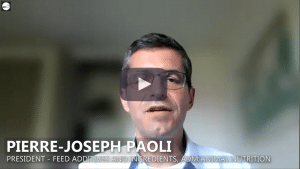Novel whole-cell yeast increases pigs to market
Supplementing sows with a novel whole-cell yeast improves reproductive performance
Novel whole-cell yeast increases pigs to market
Authors: Morgan T. Thayer and Daniel B. Jones
Published in National HogFarmer, June 2022
In the swine industry, profit potential is driven by productivity and efficiency. Nutrition, health, genetics and management practices are a few areas that can have major impacts on reproductive performance, growth performance and feed efficiency. Specifically regarding nutrition, cost effective and low inclusion specialty feed additives that provide consistent and valuable production benefits are greatly sought after by swine producers today. For instance, Pichia guillermondii is a novel whole-cell yeast with unique structure, morphology, and production benefits.
Feeding Pichia guilliermondii to sows
At a 3,200 sow commercial facility in Minnesota, 535 sows and gilts were fed 0 or 2 pounds/ton of P. guilliermondii in gestation and lactation. Females were allotted to dietary treatments at breeding. After the completion of the first reproductive cycle, a total of 358 sows remained on the same dietary treatment for second consecutive gestation and lactation. New gilts were not enrolled into cycle two.
Sows fed P. guilliermondii had 0.59 more pigs total born (P < 0.04) and 0.53 more born alive (P < 0.06) in cycle one. In cycle two, a similar magnitude of improvement was observed in total born (+0.44; P < 0.18) and born alive pigs per litter (+0.43; P < 0.18; Figure 1).
Progeny followed to market from P. guilliermondii fed sows
Pigs from cycle two sows were used to determine if feeding gestating and lactating sows and/or their progeny a proprietary strain of P. guilliermondii as a whole-cell inactivated yeast product improved progeny nursery and grow-finish growth performance and carcass characteristics.
A total of 1,260 weaned pigs were housed with 21 pigs/pen and 15 pens/treatment. The experiment was organized with a 2 x 2 factorial treatment structure with sows fed 0 or 2 lbs/ ton in gestation and lactation and pigs fed 0 or 3 lbs/ton in the nursery followed by 0 or 1 lbs/ton in grow-finish. A three-phase nursery program and five-phase grow-finish program was fed using corn, soybean meal, DDGs based diets. Pigs were marketed with equal days on feed and carcass data was collected.
During the 42-day nursery period, there was no main effect of sow diet, pig diet or their interaction on average daily gain or feed intake. There was a trend for main effect of sow diet on nursery livability where pigs from P. guilliermondii fed sows had a 2.0 percentage point improvement in livability (92.12% vs 94.11%; P < 0.130).
Pigs were marketed on day 11 (first cut) and day 132 (barn empty) of the grow-finish period. For the overall grow-finish period, pigs from P. guilliermondii fed sows had greater average daily gain (P < 0.001) and average daily feed intake (P < 0.016) compared to pigs from sows not fed P. guilliermondii (Figure 2). Final body weight was also 4.5 lbs greater when pigs were from P. guilliermondii fed sows (P < 0.016).
In alignment with the nursery period, there was an additional main effect of sow diet resulting in a 1.8 percentage point improvement in livability during the grower/finisher period (95.09% vs 96.92%; P < 0.146) when pigs were from sows fed P. guilliermondii during gestation and lactation.
Hot carcass weight of pigs from P. guilliermondii fed sows was 4.34 lbs greater than in pigs from control fed sows (P < 0.003; Table 1). Pigs from P. guilliermondii fed sows also had 0.32% greater carcass yield (P < 0.023). Additionally, when the nursery and grow-finish pigs were fed P. guilliermondii, they had 0.28% greater carcass yield compared to pigs fed control (P < 0.048).
Using market conditions and feed costs during the time of the grow-finish experiment, researchers found that pigs from P. guilliermondii fed sows earned $2.1 more carcass revenue (P < 0.01 ) and tended to have a greater carcass revenue over feed cost (P < 0.06 ).
These economical improvements were in addition to the 3.8% total improvement in wean-to-finish livability observed in this study.
Implications of feeding P. guilliermondii
The improved reproductive performance, including increased total born and born alive pigs, when supplementing sows and gilts with P. guilliermondii in gestation and lactation has been repeated in multiple experiments and evaluated in a meta-analysis.
P. guilliermondii is a demonstrated cost effective and low inclusion specialty feed additive that provides consistent and valuable production benefits. Its inclusion in gilt and sow gestation and lactation diets not only increases the number of pigs born but those pigs may also grow faster to market and a larger percentage may survive to market. These improvements certainly have potential to improve profitability through increased production and efficiency.
References:
- Peisker, M., Stensrud, E., Apajalahti, J., & Sifri, M. (2017). Morphological Characterization of Pichia guilliermondii and Saccharomyces cerevisiae Yeast and their Effects on Adherence of Intestinal Pathogens on Piglet and Chicken Epithelium In-vitro. Journal of Animal Research and Nutrition, 02(01:9). https://doi.org/10.21767/2572-5459.100029
- Thayer, M. T., Asmus, M. D., Gourley, G., Bruder, E., & Jones, D. B. (2020). 278 Feeding a whole-cell inactivated Pichia guilliermondi yeast to gestating and lactating sows over two consecutive parities. Journal of Animal Science, 98(Supplement_3), 97–97. https://doi.org/10.1093/jas/skaa054.168
- Thayer, M. T., Asmus, M. D., Jones, D. B., Gourley, G., & Bruder, E. (2022). Effects of feeding a whole-cell inactivated Pichia guilliermondii yeast in sow and/or pig diets on progeny nursery and grow-finish growth performance and carcass characteristics. American Society of Animal Science Midwest Annual Meeting. Omaha, Nebraska, USA.
- Bass, B. E., Tsai, T.-C., Yang, H., Perez, V., Holzgraefe, D., Chewning, J., Frank, J. W., & Maxwell, C. V. (2019). Influence of a whole yeast product (Pichia guilliermondii) fed throughout gestation and lactation on performance and immune parameters of the sow and litter. Journal of Animal Science, 97(4), 1671–1678. https://doi.org/10.1093/jas/skz060
- Thayer, M. T., Garcia, R. M., Duttlinger, A. W., Mahoney, J. F., Schinckel, A. P., Asmus, M. D., Jones, D. B., Dunn, J. L., & Richert, B. T. (2020). 275 Feeding a whole-cell inactivated Pichia guilliermondi yeast to gestating and lactating sows in a commercial production system. Journal of Animal Science, 98(Supplement_3), 99–100. https://doi.org/10.1093/jas/skaa054.172
- Oguey C., Thayer M., Jones D., & Samson, A. (2022). Meta-analysis of the effects of inactivated Pichia guilliermondii yeast fed to sows on progeny performance before and after weaning. 15th International Symposium on Digestive Physiology of Pigs. Rotterdam, The Netherlands.




